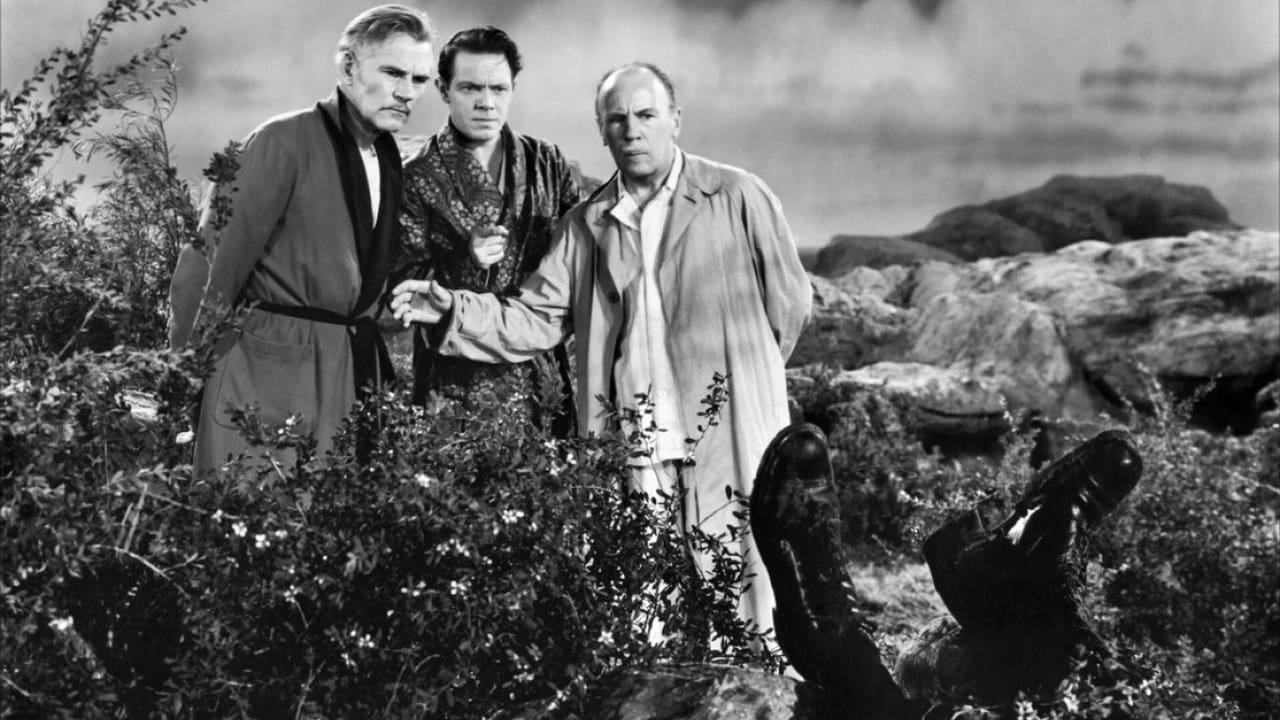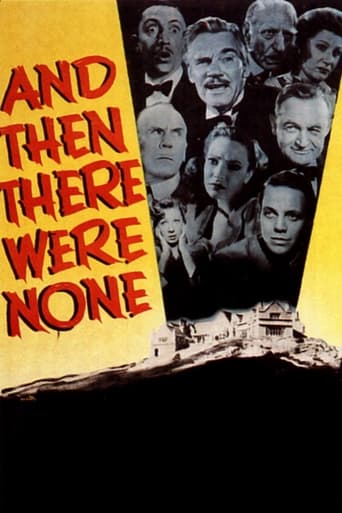

Entertaining whodunit is perhaps the best of the mysteries which uses the Ten Little Indians formula of a group of characters killed one after the other by someone among them. The methods of execution and the visual ideas (the use of knitting string which leads to a dead victim laying on her bed after a hypodermic with poison sent her to the great beyond, a fallen pair of binoculars after a brick pillar is pushed on top of a victim, chopped wood laid out strewn in front of the servant quarters of an ax victim, the clever use of cherubic statuettes representing the victims (each of which is shattered or broken once someone among the group is murdered), etc.) are directed in spirited fashion by an inspired crew under René Clair's guidance. The setting is perfect (a manor on an isolated island where a series of murders could take place without the concern of interference of others beyond the group themselves) for the Agatha Christie mystery. The cast is full of colorful faces and characterizations with particular standouts, Walter Huston (celebrated director, John Huston's, father) as a doctor and the delightful Barry Fitzgerald as a judge, both of whom "were selected" by an unknown party named Mr. UN Owen (get it, unknown?) to end up on the island as guests to be selectively offed in a variety of ways. Here's the deal: ten "Indians" arrive on the island at the request of a man their friends supposedly know. There's a butler and his cook wife, already at the location, but they are unaware of who Mr. Owen is. They will soon be a part of the killer's masterplan. Each person selected is supposedly responsible for the death of someone. Whether it is their actions causing a suicide (Judith Anderson, completely calm and without distress, just knitting, not a care in the world, responsible for putting away a kid because "he was bad"; the kid would kill himself as a result), wrongly convicting someone or being a reason for someone being imprisoned (Fitzgerald and cop Roland Young), or a problem with booze (Huston, his doctoring resulted in a patient's death, "social drinker and entertainer" (and a "prince" no less) Mischa Auer, who had a DUI resulting in the vehicular homicide of a couple; Mischa's bouts with the drink are obvious, as his obnoxiousness wearies the group almost immediately); this group has a sketchy past that someone among them believes is enough to see them meet poetic justice. Louis Hayward arrives with a medicine case (one a traveling doc would carry) with a different name than what he calls himself which might be a clue as to his reasons for being on the island. The very pretty June Duprez is the innocuous and sweet secretary called to the island by Owen for a job position or so she thought. June continues to deny she was involved in any murder while most of the others confess to contributing or directly causing a death. Some do so with little regard for what happened, devoid of guilt, more worried about their own skin that recognizing *why* they are going through this.What makes the film fun for me is seeing them eventually question each other on who among them is the killer, deducing and speculating, looking over each other's shoulder, and forming alliances. Louis and June are both about the same age and share a budding romance blooming, while Fitzgerald and Huston (it seems) are in cahoots together to achieve an unveiling of the identity of the killer. A wonderful C Aubrey Smith ("The Four Feathers" and Hitchcock's "Rebecca") is the elderly, near-deaf General Sir John Mandrake, often speaking aloud about his wife, befriends June; I think out of the cast, he's the least suspect (his bouts of senility, which often has him mentioning his wife, kind of indicate this whole ordeal is speeding up his eventual demise).Clair's À Nous la Liberté, a precursor to Chaplin's Modern Times, came a decade before this, and you can see all that returning visual mastery on display in how the mystery developed itself often by using the camera as a pair of eyes (very Hitchcockian), as it follows (with the remaining survivors) the ensuing plot's unraveling. The murders are sometimes discovered by characters off screen (maid servant Queenie Richards is so overwhelmed at a record played (the one produced by Owen that details each murder committed by those present on the island) by her butler husband (Richard Hayden) that she goes to bed and never awakens, found dead the next day), and through dialogue tell the viewer how they occurred.But I think the movie is at its best when Clair carefully shows crime scenes through stylistic ways that paint a picture of what happened, imaginatively setting out the bodies to be found by the characters with tricks on what his camera does and doesn't see. The really talented directors could often take the limits placed on them by censorship and adopt a different strategy, incorporating a less is more approach. There's no in-your-face in 1945. Still, the cast expertly play along. This is all sweet music, with everything falling into place beautifully.
... View MoreWell, it was a famous exit line, so we'll never know if he finally did "get it" or not. This, the earliest screen version of the classic whodunit novel of the same name, takes some liberties with it, but remains the best version over the countless other versions of this story even after 70 years.Eight guests are invited and two house servants are hired to a secluded island by a man none of them knows. They learn all too late that they are being punished for murders they each got away with, when, one by one, each is being murdered. The murderer further taunts his remaining victims by marking each death with the disappearance of one of ten little Indians statues. He uses the Ten Little Indians poem as a framework for each murder. At first, it appears the murderer is hiding on the island somewhere, but soon it becomes evident he is one of the ten. Once everyone suspects each other, the tension builds well.Great characterizations are done by a wonderful cast, and the story unfolds in just the right manner to keep you guessing. The spooky house environment provides a perfect setting for the action.The original book's ending was stronger, but this movie's alternative works OK.See if you can guess whodunit, but be forewarned: if anybody named U.N. Owen, that you've never met, ever invites you to an island, turn down the invitation.
... View MoreTen people are invited to the island home of the mysterious Mr. U.N. Owen (get it?). One by one, they are killed off while they try to figure out who is behind it all. The best adaptation of Agatha Christie's novel "Ten Little Indians." Probably the best movie based on any Christie story. The cast is so good that it should easily be included among the best casts of all time. Walter Huston, Barry Fitzgerald, Louis Hayward, Judith Anderson, C. Aubrey Smith, Mischa Auer, Roland Young, and so on. Exceptional cast. Whether you are familiar with Agatha Christie's story or not, you will no doubt recognize this plot as it's been done countless times in film and television since. Heck, it's the backbone of the modern slasher film really. But it's never been done as well or as smart as this. A suspenseful classic everybody should see.
... View MoreSometimes a viewer can tell if a film has been heavily edited due to the production code. This is especially noticeable with some endings. It looks like the story should conclude one way, then it abruptly goes in another direction at the last minute, so that we have a more morally- correct resolution.This seems acceptable if there is something 'good' about it. But there are times when one wishes the ending to be morally incorrect, because the story should function as a realistic depiction of what happens when people do go bad and life does go wrong. These can be powerful films that teach powerful lessons.Another problem is that after the end of the production code, producers who remake these films with flawed endings often do not seem to fix them correctly. But occasionally, there is a remake that comes along that does return to the original source and lets the story play out the way the writer intended.And Then There Were None, with its remake called Ten Little Indians, is one such example. The updated version was made before the Hollywood production code was abolished, in 1965 in Europe. The cast may seem a bit inferior to the group of actors in the original, but the story is filmed the way Agatha Christie wrote it. A couple of killers are allowed to live happily ever after and a mass murderer is allowed to commit suicide to evade justice.
... View More